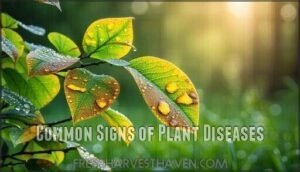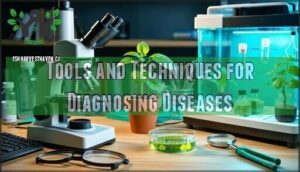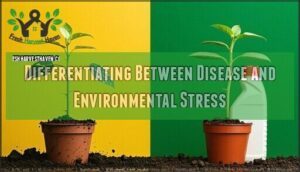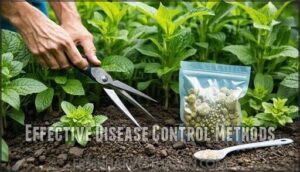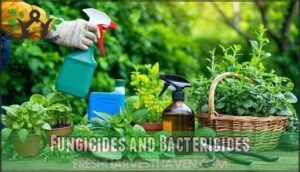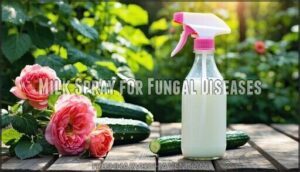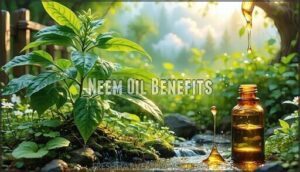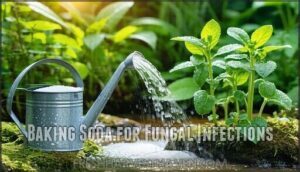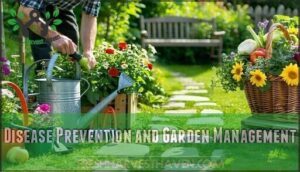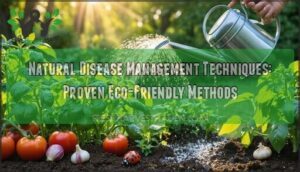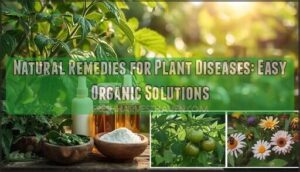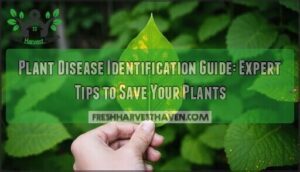This site is supported by our readers. We may earn a commission, at no cost to you, if you purchase through links.
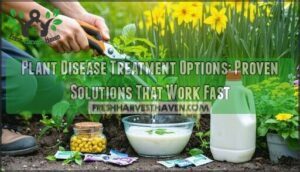 When your plants look sick, you’ve got several plant disease treatment options that actually work.
When your plants look sick, you’ve got several plant disease treatment options that actually work.
Start by removing infected leaves and branches – think of it as plant surgery. Organic solutions like neem oil, milk spray, and baking soda mixtures tackle fungal problems naturally.
For tougher cases, targeted fungicides and bactericides get the job done quickly. Beneficial microbes can also outcompete harmful pathogens, turning your soil into a protective shield.
The key is matching your treatment to the specific disease you’re fighting. Smart gardeners know that timing matters more than the treatment itself.
Table Of Contents
- Key Takeaways
- What Are Plant Diseases?
- How to Identify Plant Diseases
- Effective Disease Control Methods
- Chemical and Natural Treatment Options
- Disease Prevention and Garden Management
- Frequently Asked Questions (FAQs)
- What are the methods of plant disease management?
- What are the 5 plant diseases?
- What are the four major principles of plant disease management?
- How are plant diseases treated?
- How can plant diseases be prevented?
- What is effective Plant Disease Control?
- How do you treat a plant disease in a greenhouse?
- What are some common plant diseases?
- How can a farmer prevent a disease?
- What is the best way to solve plant diseases?
- Conclusion
Key Takeaways
- You’ll stop plant diseases fast by removing infected leaves and branches immediately – think of it as plant surgery that prevents spread to healthy tissue
- You can tackle most fungal problems naturally using organic solutions like neem oil, milk spray, and baking soda mixtures before resorting to chemical treatments
- You’ll get better results by matching your treatment to the specific disease you’re fighting rather than using generic approaches for all plant problems
- You’ll prevent most diseases through smart garden management – regular inspections, proper watering techniques, crop rotation, and maintaining good air circulation around your plants
What Are Plant Diseases?
Plant diseases occur when harmful microorganisms or environmental factors disrupt your plant’s normal growth and development.
These disorders can quickly spread through your garden, weakening plants and reducing yields if you don’t address them promptly.
Factors Contributing to Plant Disease
Beyond just dodging raindrops, your plants face a perfect storm of challenges that weaken their natural defenses.
Environmental stressors like drought, poor drainage, and extreme temperatures create entry points for plant pathogens.
Climate change intensifies these plant disease risk factors, while poor sanitation practices accelerate plant disease spread through contaminated tools and soil.
When plants can’t fight back effectively, pathogen introduction becomes inevitable.
Recognizing early disease indicators like yellowing leaves can help gardeners take swift action.
Common Pathogens: Fungi, Bacteria, Viruses, Nematodes
Four main plant pathogens wage war against your garden’s health.
Fungal infections create powdery coatings and leaf spots, thriving in humid conditions.
Bacterial diseases cause wilting and water-soaked lesions through wounds or natural openings.
Viral transmission spreads through insects or contaminated tools, creating mosaic patterns and stunted growth.
Nematodes attack roots underground, causing mysterious decline symptoms that puzzle gardeners everywhere, due to viral transmission.
How Diseases Affect Plant Growth and Health
When plant diseases strike, they don’t just damage leaves—they hijack your plant’s entire system.
Plant diseases don’t just attack—they completely take over your garden’s defense system
Growth inhibition occurs as pathogens steal nutrients, causing nutrient deficiency that weakens structure and disrupts photosynthesis impact.
Fungal diseases particularly affect reproduction effects, preventing flowering and fruiting.
Understanding plant disease symptoms helps you recognize when plant health deteriorates, enabling faster plant disease treatment before permanent damage occurs.
How to Identify Plant Diseases
Before you can treat plant diseases effectively, you need to know what you’re dealing with.
Think of it like being a plant detective – the clues are right there on the leaves, stems, and roots if you know what to look for.
Common Signs of Plant Diseases
Recognizing plant disease symptoms starts with spotting leaf discoloration—yellowing, browning, or unusual color changes that signal trouble.
Watch for wilting patterns, stunted growth, and spot types like water-soaked lesions or powdery patches.
Unusual growths, distorted leaves, and musty odors help with plant disease identification.
Early plant disease symptoms recognition prevents widespread damage.
Tools and Techniques for Diagnosing Diseases
Getting the right diagnosis means using the right tools for the job. Start with simple symptom observation using a magnifying glass or hand lens to spot early signs like discoloration or unusual growths.
Here are five diagnostic techniques for accurate plant disease identification:
- Microscopes – Examine spores, bacteria, and cellular damage at high magnification
- Pathogen culturing – Grow samples in lab conditions to identify specific organisms
- Imaging techniques – Use UV or infrared photography to reveal hidden symptoms
- Microbial analysis – Test soil and plant tissue for pathogen presence
- Genetic testing – DNA analysis confirms exact disease strains
These methods help you move beyond guesswork and get definitive answers about what’s attacking your plants. Remember that early detection matters to prevent widespread issues.
Differentiating Between Disease and Environmental Stress
Sometimes plants look sick but aren’t actually diseased – they’re just stressed out.
You’ll notice symptom overlap between stress vs. disease situations, making diagnostic differences tricky.
Environmental factors like poor drainage, extreme temperatures, or nutrient deficiencies can mimic disease symptoms perfectly.
A holistic assessment examining environmental conditions alongside plant diseases helps distinguish real infections from stressed plants needing better care.
Effective Disease Control Methods
When you’ve spotted the telltale signs of plant disease, it’s time to take action with proven control methods that stop problems in their tracks.
You’ll discover that combining smart pruning techniques with beneficial microorganisms creates a powerful defense system that protects your plants while promoting healthy growth.
Pruning Infected Plant Parts
When sharp pruning tools cut away diseased tissue, you’re literally removing the infection’s foothold in your plant.
Always sterilize your pruning tools between cuts using rubbing alcohol to prevent disease spread. Time your cuts during dry weather when wounds heal faster.
Immediately bag and dispose of infected material—never compost it. Apply wound treatment paste to larger cuts on valuable plants.
These plant disease control methods stop fungal infection treatment needs before they escalate. To further combat fungal issues, consider improving air circulation methods.
Biological Control Agents
Beyond pruning, you can harness nature’s own warriors through biological control agents—beneficial microbes that fight plant diseases naturally.
These organic disease control solutions offer impressive agent efficacy while supporting environmental sustainability.
Here’s what makes biological control so powerful:
- Bacillus subtilis strains colonize plant roots, creating protective barriers against soil pathogens
- Trichoderma fungi outcompete harmful organisms while boosting disease resistant plants’ natural defenses
- Pseudomonas bacteria produce antibiotics that suppress bacterial and fungal infections
Commercial availability has expanded dramatically, with microbe application becoming standard practice.
You can even find various product options online.
Unlike synthetic chemicals, these natural remedies won’t trigger resistance management issues in pathogens.
You’ll find them as soil drenches, foliar sprays, or seed treatments, making plant disease resistance enhancement both accessible and environmentally responsible.
Microbial Consortia for Plant Health
Unlike single-strain treatments, microbial consortia combine multiple beneficial microorganisms that work together like a well-orchestrated team.
Nature’s army of microbes beats disease better than any single fighter ever could
These consortia benefits include superior disease suppression through diverse attack mechanisms—some microbes produce antibiotics while others compete for nutrients.
This multi-pronged approach strengthens your soil microbiome, creating enhanced immunity that protects plants naturally.
It’s sustainable agriculture at its finest.
This approach leverages natural plant-microbe associations to enhance plant health.
Plant Growth-Promoting Fungi Benefits
Plant growth-promoting fungi offer powerful organic treatments that naturally boost your garden’s defenses.
These beneficial microorganisms work like tiny plant bodyguards, forming partnerships that strengthen disease resistance and improve overall health through biological control mechanisms.
Here’s how these fungal allies transform your plant disease treatment options:
- Enhanced Nutrient Uptake – Mycorrhizal fungi increase phosphorus absorption by up to 70%, making plants stronger and more resilient against pathogens
- Disease Resistance Boost – Trichoderma species reduce root rot by 80% while triggering natural immune responses in your plants
- Improved Root Growth – Growth-promoting hormones from fungi extend root systems by 60%, creating better nutrient access and stability
- Stress Tolerance – Fungal partnerships help plants survive drought conditions with 55% better yield retention compared to untreated specimens
These biocontrol potential benefits make fungicide applications less necessary while providing long-term disease prevention that chemical treatments can’t match.
Chemical and Natural Treatment Options
When your plants show signs of disease, you’ve got two main treatment paths: chemical solutions that work fast and natural remedies that are gentler on the environment.
Both approaches can save your garden, but knowing when to use each one makes all the difference in getting your plants healthy again.
Fungicides and Bactericides
Chemical fungicides and bactericides offer rapid, targeted plant disease treatment options when biological methods aren’t enough.
Systemic action products circulate through plant tissues, providing lasting protection against pathogens. Contact treatments work on leaf surfaces but require reapplication.
Application timing before infection occurs maximizes bactericide efficacy and prevents fungicide resistance.
Consider exploring options for effective plant protection to combat fungal diseases.
Follow chemical safety guidelines and rotate active ingredients to maintain effectiveness, ensuring the use of these products is both safe and effective.
Milk Spray for Fungal Diseases
Milk composition contains proteins that combat fungal diseases like powdery mildew effectively.
You’ll mix one part whole milk with nine parts water for spray preparation. Apply this homemade plant remedy weekly during early morning hours for maximum absorption.
The treatment works best on specific diseases affecting roses, cucumbers, and squash. Skim milk alternatives provide similar antifungal benefits while reducing potential leaf residue concerns.
Sulfur Dust Application
Dusting your plants with sulfur offers powerful organic treatment against stubborn fungal infections that resist other methods.
Apply sulfur dust early morning when leaves are slightly damp, ensuring even coverage on both leaf surfaces.
This time-tested fungicide creates an inhospitable environment for powdery mildew and other fungal diseases.
Reapply every 7-10 days during active infections, but avoid application during hot weather above 85°F to prevent leaf burn.
The treatment should be carefully managed to ensure effectiveness and plant safety, making sulfur a valuable tool in the fight against fungal diseases.
Neem Oil Benefits
Beyond sulfur’s protective coating, neem oil offers you a versatile organic pesticide that tackles both pests and diseases simultaneously.
This natural plant protector disrupts fungal spores while repelling harmful insects, making it one of the most effective homemade plant remedies available.
You’ll find neem oil uses extend from preventive treatments to active fungal treatment, delivering thorough pest control in one application.
Neem oil is often used in conjunction with other methods for effective oil treatment methods to achieve ideal results, providing a comprehensive approach to plant protection.
Baking Soda for Fungal Infections
You’ll find baking soda creates an alkaline environment that stops fungal spores from germinating effectively.
Mix one teaspoon per quart of water for powerful Fungal Treatment against powdery mildew and black spot.
These Natural Remedies work as preventive Organic Solutions rather than curative fungicides.
Apply weekly during humid conditions when Fungal diseases thrive, ensuring complete leaf coverage for maximum Fungus Control results.
Disease Prevention and Garden Management
You can’t treat what you can’t prevent, and smart garden management stops diseases before they start.
Prevention beats cure every time, saving you money, time, and the heartbreak of losing beloved plants to infections that could’ve been avoided with simple daily habits.
Regular Plant Inspection
You’ll catch problems early with regular Visual Checks every few days.
Plant Monitoring becomes second nature when you walk through your garden with purpose.
Disease Tracking helps you spot patterns—maybe that tomato always gets blight after rain.
Inspection Tools like magnifying glasses reveal tiny symptoms before they spread.
Early Detection saves your plants and your sanity when disease symptoms identification becomes routine habit.
Effective disease management involves understanding and applying disease prevention methods to protect your garden, using techniques like Regular Inspection and Disease Tracking for Early Detection.
Quarantine Procedures for New Plants
New plant intake requires careful disease screening to protect your garden’s health.
Think of quarantine as your garden’s security checkpoint—it’s easier to prevent problems than fix them later.
Proper isolation methods and plant acclimation help guarantee disease management success.
- Isolate new plants for 2-3 weeks in a separate area before introducing them to your main garden
- Inspect thoroughly for signs of disease, pests, or unusual discoloration during the quarantine period
- Monitor daily for symptoms like wilting, spots, or stunted growth that indicate potential health issues
- Practice nursery sanitation by cleaning tools and containers used during the quarantine process
Crop Rotation Benefits
Crop rotation acts like giving your garden a fresh start each season.
You’ll break disease cycles by switching plant families annually, preventing soil-borne pathogens from establishing strongholds.
This practice enhances soil health through improved nutrient cycling while reducing pest control needs.
Smart crop rotation boosts disease suppression by up to 70%, naturally supporting integrated pest management and pathogen control for healthier crop yields.
Proper Watering Techniques
Proper irrigation isn’t rocket science, but mastering these watering techniques can make or break your plant disease treatment options.
Smart watering prevents fungal diseases and bacterial diseases from taking hold in your garden.
- Water at soil level – Direct water to roots using drip irrigation to keep leaves dry
- Check soil moisture – Stick your finger 2 inches deep before watering again
- Morning watering – Early irrigation allows plants to dry before evening humidity peaks
- Water quality matters – Use clean, pH-balanced water to avoid introducing pathogens
- Avoid overwatering risks – Soggy soil creates perfect conditions for root rot and other diseases
Water conservation through proper timing and placement keeps plants healthy while reducing disease pressure.
Soil Solarization Techniques
Beyond proper irrigation practices, soil solarization techniques offer powerful thermal treatment for soil disinfestation.
Cover moist soil with transparent plastic sheets during summer’s hottest months. This solar mulch traps heat, reaching temperatures of 37-60°C for four to six weeks.
The soil heating process eliminates fungal pathogens, nematodes, and weed seeds by 90-100%. Conduct soil tests before and after soil pasteurization to monitor effectiveness.
Frequently Asked Questions (FAQs)
What are the methods of plant disease management?
You’ll tackle plant diseases through prevention, cultural practices, and treatments.
Clean tools, rotate crops, choose resistant varieties, and maintain proper spacing for airflow.
Apply fungicides or biological controls when needed for effective management.
What are the 5 plant diseases?
Sixty percent of crop losses stem from five major plant diseases you’ll encounter:
powdery mildew creates white dusty coatings,
black spot causes dark leaf patches,
root rot triggers wilting from soggy conditions,
rust produces orange pustules,
and blight rapidly browns entire plant sections.
What are the four major principles of plant disease management?
You’ll master plant disease management through four key principles: prevention through proper sanitation and plant spacing.
Early detection via regular monitoring, cultural controls like crop rotation, and targeted treatments using fungicides or biological controls when needed.
How are plant diseases treated?
You’ll treat plant diseases using three main approaches: cultural practices like proper spacing and sanitation, biological controls with beneficial microbes, and chemical treatments including fungicides and bactericides when needed.
How can plant diseases be prevented?
Prevent plant diseases by maintaining proper spacing for air circulation, rotating crops annually, sterilizing tools between plants, avoiding overhead watering, removing diseased debris promptly, and choosing disease-resistant varieties.
What is effective Plant Disease Control?
Effective plant disease control combines prevention with targeted treatment.
You’ll need proper sanitation, resistant varieties, crop rotation, and good air circulation.
When diseases strike, use fungicides, bactericides, or biological controls based on accurate identification for best results.
How do you treat a plant disease in a greenhouse?
Identify the specific disease first, then isolate affected plants immediately. Remove infected leaves and debris, improve air circulation, and apply targeted fungicides or biological controls based on the pathogen type.
What are some common plant diseases?
Common plant diseases you’ll encounter include powdery mildew (white dusty coating), root rot (wilting from waterlogged soil), leaf spot (dark circular lesions), rust (orange pustules), and bacterial blight (rapid browning).
How can a farmer prevent a disease?
Smart farmers know that an ounce of prevention beats a pound of cure. You’ll want to rotate crops annually, maintain proper plant spacing, clean tools between uses, and choose disease-resistant varieties for your growing conditions.
What is the best way to solve plant diseases?
You’ll tackle plant diseases best through prevention—use resistant varieties, maintain proper spacing, rotate crops, and keep tools clean.
When problems arise, combine cultural practices with targeted treatments like fungicides or beneficial microbes.
Conclusion
Think of your garden as a battlefield where you’re the commanding general.
Successful plant disease treatment options depend on quick action and smart strategy. Remove infected parts immediately, then deploy organic weapons like neem oil and milk spray for mild cases.
For serious infections, targeted fungicides deliver knockout punches.
Prevention beats cure every time—inspect regularly, rotate crops, and maintain proper watering.
Remember, healthy plants resist disease naturally, so focus on building their strength alongside treating symptoms.
- https://www.flickr.com/photos/scotnelson/?
- https://www.sciencedirect.com/science/article/pii/S2590207525000322
- https://biomesolutions.com.br/wp-content/uploads/2024/06/1-s2.0-S104996442400001X-main.pdf
- https://enviromicro-journals.onlinelibrary.wiley.com/doi/full/10.1111/1751-7915.14330
- https://apbb.fftc.org.tw/article/611

